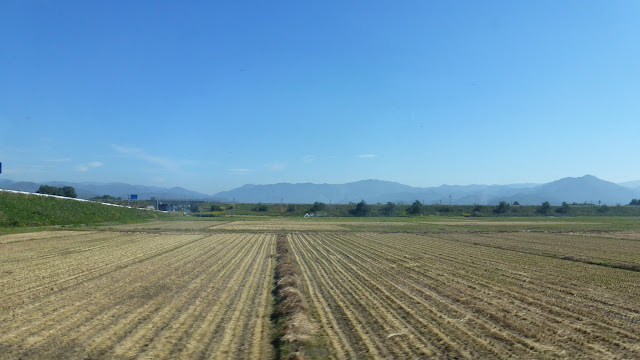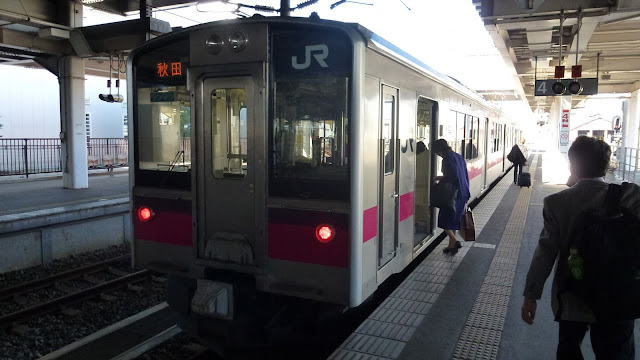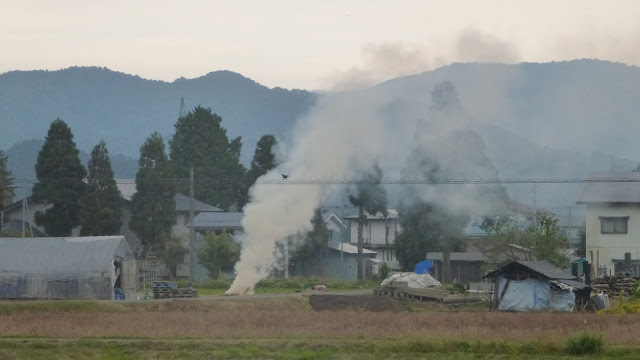Once out of immigration I go straight down the escalators to the JR East office. There I purchase a five day JR East pass, allowing me travel on trains in the Kanto and Tohoku regions. Unlike a full JR Pass, these can be bought in Japan.
There were so many options on the trip, so many railway lines to catch. I have settled on an itinerary that will take me all the way up to Hirosaki in the far north of Honshu. But not on the Shinkansen to Shin-Aomori and then a local train to Hirosaki. No, I already did that in June. Instead I'll be going up the middle of the island, on the Yamagata Shinkansen, then local and private lines up to Hirosaki. The following day I plan to go all the way down the Western coastline back down to Hirosaki. My objective is eventually to do the entire Western coast of Honshu.
I reserve seats on the Narita Express and Yamagata Shinkansen portions of my trip, then have an hour or so to waste. Like so many arrival areas, which people tend to leave quickly, Narita's appears quite shoddy. I clean myself in the bathroom, have a shave, change to long pants. There are shower rooms for Y1000 (~A$12), but I figure last night's lounge was sufficient.
Looking at the sim card and portable wifi router prices at the airport desks I regret having preordered mine through the excellent eConnect. That way I could already have access to one rather than having to wait until reaching my hotel in Hirosaki.
It's time to descend to the platform to catch the Narita Express. Nine years ago the N'EX was my introduction to Japan, and what a fine one it is. Now a more modern train with combination lock luggage racks, information screens, wifi for Japanese service subscribers and power to the seat, great for recharging my phone, it is smooth, spacious and comfortable. Just what is needed after a nine hour flight.
As soon as the train exits the airport tunnel you realise that the airport really isn't in Tokyo. Instead there is rural scenery, rice fields interspersed with jungle and bamboo clad hills, a tropical landscape. In the distance is Narita's Shinshoji pagoda, the first sign that you are really in Japan.
In my original five-day itinerary I had planned to spend the morning in Narita, walking the old shop-lined Omotesando up to Naritasan and exploring the temple grounds, later continuing on to Tokyo to relax in my favourite Shinjuku Prince Hotel. A slow day to recover from the long flight.
Now I have a twelve hour journey ahead of me. I figure that I can relax and sleep on the NEX and the initial Shinkansen ride, having at least seen the sights before.
However, I can't yet seem to sleep. Instead I listen to music and watch so green rural Japan change into grey suburbia. It's comforting in its familiarity. As we enter the satellite city of Chiba I see another of my "plans" overhead. I have long wanted to catch the underslung Chiba Urban Monorail, but decide to wait until Alex is with me. I'm sure he'd love it.
It seems wrong that the Tokyo station stop of the NEX is such an awfully dark and nondescript tunnel.. Despite the grandeur of the recently renovated station above the ground it feels like any old subway stop.
I have a short time here before I must catch the next train. The food options seem limited. I buy a croque monsieur (ham and cheese toast) from a bakery, then rush up to the Shinkansen platforms.
My silver, green and blue and blue Tsubasa superexpress to Shinjo is coupled up to a silver, pink and blue service to Akita. The two trains uncouple at Fukushima to go their different ways.
Unfortunately, I have not been able to book a window seat for this service, which is not particularly spacious with legroom, unlike the JR West Shinkansens. As we pull smoothly out of the station I think I fall asleep. That's okay, because, as I say, I saw this bit twice earlier this year.
I wake up prior to arriving at Fukushima. Under clear blue skies there is a magnificent view of Mount Azuma, an active volcano overlooking this now infamous city. Active volcanoes, even quietly active ones like Azuma, with their bare calderas, are a source of fascination for an Australian, as we have none on our mainland.
We uncouple from the Komachi superexpress and it is time to make our way inland. Unlike the main north-south Shinkansens, which travel on elevated railway lines at high speed, this is a "mini-Shinkansen", which run slower and at ground level, but on standard gauge track rather than Japan's normal narrow gauge.
This isn't a bad thing, I think as we wind our way up into the mountains. The scenery here is fantastic, mountain valleys, forests and farmland, a close look at the landscape. It is definitely the most beautiful Shinkansen route that I've caught, and I've been as far north and south on the them as you can go.
Mmm, that croque monsieur is really good. But it's my only lunch.
Shinjo, a small rural city, seems an unlikely terminus for a Shinkansen line. I believe that all sorts of political reasons were involved for the decision, though it has been in existence for twenty years as of June. I have little time to ponder this as my next train will be departing shortly.
I climb into silver and pink striped two car local electric train bound for Akita. No more booked luxury seats, the inward facing benches are mostly filled with elderly locals. In recompense, it is possible to get a view out the front of the train and I spend a lot of time standing at that window.
The train rattles off, quiet as electrics are, and at a decent pace. We pass along river valleys, past pine forests and alongside a mountain range. Now and then there are hints of autumn. Red leafed vines, yellowed trees. I have read that the foliage colouration is not as good this year due to the hot summer. Colourful foliage was one of the reasons I travelled north at this time of year.
Feather-topped reeds sway as the train races past. Rural towns, farms of fruit and vegetables in addition to the the ubiquitous rice paddies. The passengers are mostly the elderly or school aged. There's a dreamy feel to this landscape, as if time moves at a different rate to the big coastal cities.
One and three quarter hours after boarding I leave the train at Omagari for a very short Komachi Shinkansen ride one station back to Kakunodate. All seats are reserved, but I haven't had time to get one, so I stay in the vestibule area. As I had a rail pass there wouldn't be an issue, but it allowed me to look out the window anyway.
The light is dull and grey as I get off at Kakunodate. The Lonely Planet holds this as an attractive town of samurai and merchant villas. Earlier in the year I had a choice to explore Kakunodate or Hirosaki and chose the latter. Now I have forty minutes to see if my decision was sound. I set off at a hurry to explore.
I walk up the "shotengai", the shopping street leading off the station, then turn right towards the cherry tree lined samurai villas. A canal (or drain) of water separates the fenced villas from the road. These are black fences of solid wood, but gates are often left open to peer into the sometimes ornate gardens. I can't tell which villas are open for inspection, bar one near the end. To me, the street lacks the atmosphere of the samurai area of Kanazawa and I find myself a bit disappointed.
I'm also running out of time. I speed back the way I came, stopping only to admire the dated concrete architecture of the main street, finding beauty in its decay. I make it to the station with only a couple of minutes to spare, purchase my ticket from a machine and jump aboard the Akita Nairiku Jukan railway diesel car.
The Akita Nairiku Jukan line is private, so my pass doesn't cover it. It's a "third sector" line, operated by a private company in conjunction with local authorities. These lines tend to have poor patronage and financials, so I am eager to catch them before they disappear.
Only the rear car is in use. The front carriage looks to be a low tabled dining car with tatami mat flooring, but it is locked off with only the driver inside. My fellow passengers include school children and the elderly.
I've read that the line isn't particularly scenic, but I must beg to disagree. I found the mountain and rural scenery very attractive as we chugged along, but tiny stations that were mere platforms and sheltered waiting rooms. I must have fallen asleep at some point. Later a large group of elderly participants in some sort of outdoor activity - perhaps a walk - joined the train, only to leave again a few stations beyond.

It began raining and becoming very gloomy outside as the last of the day ebbed away. At Aniai, the headquarters of the line, we stopped while the front car was decoupled from the train. Apparently they serve horsemeat on rice in the station cafe. I should like to have had the time to get on and off the train to stroll through these tiny places, especially Animaeda station, which is home to an onsen called "Quince Moriyoshi". Sadly, by the time we got underway again night had fallen.
The rest of the journey was travelled in darkness. Sometimes we could peer inside the windows of a house to see a family sitting down for dinner. Other times, the only sign of any commerce in a town were the bright lights of a vending machine. I loved the little night vignettes all the same.
My two and a half hour journey ended when we pulled into Takanosu, home of the world's largest taiko drum. It was cold, dark and wet outside and I was very hungry and tired. The station was very much alive with high school kids waiting for a train ride home. A small cafe at the station sold ice cream, snacks and perhaps a hot meal, but I couldn't decipher what, nor whether I had the time to eat it. A quick walk along the shotengai was no help in locating food either, instead finding stationery and toy robot models. Eventually I crossed to the opposite platform hungry and waited for the Limited Express Tsugaru to arrive.
I was most impressed by the train, very modern and comfortable, perfect for this last leg. A little less than an hour later and I had arrived at Hirosaki, a town famous for its apples. Even the shopping centre attached to the station is called "Appliese".
It was only half an hour before the shops would close, so I went a purchased some local apple snacks, the best being some chewy baked apples with lots of cinnamon spice. Then I checked in at the Toyoko Inn hotel adjacent to the station.
A Toyoko Inn is a Toyoko Inn - a basic standard business hotel chain. The familiarity was fine for me tonight as I was absolutely exhausted. I still needed dinner though, so I stepped out into the rain and walked up towards the shopping area, dominated by an Ito-Yokado "discount" department store that we had enjoyed last visit. Or Alex had enjoyed for the play area in the kids section.
They were closing for the night, but the supermarket and food court beneath were still open and, not wanting to get any wetter, I decided to eat there. Big mistake. The ramen noodles were awful, the soup the product of flavour sachets. Too late, I had paid for it.
From the supermarket I bought some more apple food - apple chocolate cake for instance.
I wandered back to the hotel along the very quiet and damp streets, cleaned up and fell into a de






















































Comments